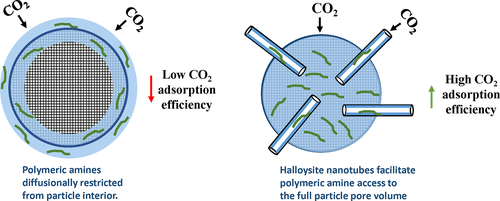当前位置:
X-MOL 学术
›
Ind. Eng. Chem. Res.
›
论文详情
Our official English website, www.x-mol.net, welcomes your feedback! (Note: you will need to create a separate account there.)
Tubular Clay Nano-Straws in Ordered Mesoporous Particles Create Hierarchical Porosities Leading to Improved CO2 Uptake
Industrial & Engineering Chemistry Research ( IF 4.2 ) Pub Date : 2022-01-18 , DOI: 10.1021/acs.iecr.1c03645 Azeem Farinmade 1 , Oluwole Ajumobi 1 , Lei Yu 2 , Yang Su 1 , Yueheng Zhang 1 , Yueyun Lou 1 , Julia A. Valla 2 , Vijay T. John 1
Industrial & Engineering Chemistry Research ( IF 4.2 ) Pub Date : 2022-01-18 , DOI: 10.1021/acs.iecr.1c03645 Azeem Farinmade 1 , Oluwole Ajumobi 1 , Lei Yu 2 , Yang Su 1 , Yueheng Zhang 1 , Yueyun Lou 1 , Julia A. Valla 2 , Vijay T. John 1
Affiliation

|
The use of solid adsorbents for CO2 capture is of importance in the development of technologies to remove this greenhouse gas. High surface area mesoporous materials are used to encapsulate or functionalize amines that selectively capture CO2. The MCM-41 class of hexagonally ordered mesoporous silicas have surface areas between 1000 and 1500 m2/g, which in principle allows a significant degree of capture when amines such as polyethyleneimine (PEI) are encapsulated within the pores and occupy the entire surface area of the materials. However, the tight 3 nm pore channels of MCM-41 create a challenge to the infiltration of PEI throughout the pore volume, resulting in much lower CO2 uptake at high PEI concentrations. This work describes the introduction of clay nanotubes (halloysite) with an inner diameter of 15–30 nm into MCM-41 pellets to mitigate such diffusional restrictions. The introduction of the nanotubes is through a one-step ship-in-a-bottle approach to synthesis in an aerosol-assisted system where MCM-41 is synthesized in droplets containing the halloysite. The morphology of the composite material is such that several nanotubes extend from the interior and protrude through the surface of the pellet like straws. These ceramic nanotubes are 0.5–2 μm in length, and their lumen diameter ranges from 15 to 30 nm, thus providing an improved entry pathway for molecules to access the interior of the MCM-41 pellets. The concept is used to enhance PEI loading in MCM-41, which leads to a significant increase in CO2 uptake levels. MCM-41 composites with halloysite nano-straws (MCM-41/HNT) show a doubling of CO2 uptake levels (7.1 wt %) and uptake kinetics (k = 0.11 s–1) in comparison to MCM-41 sorbents (3.9 wt % and k = 0.05 s–1) at 50 wt % PEI loading. This indicates the potential validity of the nano-straws to improve access to the interior of MCM-41, thus coupling enhanced molecular transport with a high surface area material. The generality of the concept indicates further applications to adsorption and catalysis.
中文翻译:

有序介孔颗粒中的管状粘土纳米吸管产生分级孔隙,从而提高二氧化碳的吸收
使用固体吸附剂捕获 CO 2在开发去除这种温室气体的技术中非常重要。高表面积介孔材料用于封装或功能化选择性捕获 CO 2的胺。MCM-41 类六角有序介孔二氧化硅的表面积在 1000 和 1500 m 2 /g 之间,原则上当聚乙烯亚胺 (PEI) 等胺被封装在孔内并占据整个表面积时,可以实现显着程度的捕获的材料。然而,MCM-41 紧密的 3 nm 孔通道对 PEI 在整个孔体积中的渗透提出了挑战,导致 CO 2低得多在高 PEI 浓度下吸收。这项工作描述了将内径为 15-30 nm 的粘土纳米管(埃洛石)引入 MCM-41 颗粒以减轻这种扩散限制。纳米管的引入是通过一步装瓶的方法在气溶胶辅助系统中合成的,其中 MCM-41 在含有埃洛石的液滴中合成。复合材料的形态使得几个纳米管从内部延伸并像吸管一样突出穿过颗粒的表面。这些陶瓷纳米管的长度为 0.5–2 μm,其管腔直径范围为 15 至 30 nm,从而为分子进入 MCM-41 颗粒内部提供了改进的进入途径。该概念用于增强 MCM-41 中的 PEI 负载,从而导致 CO 的显着增加2个摄取水平。与MCM-41 吸附剂 (3.9 wt%) 相比,具有埃洛石纳米吸管 (MCM-41/HNT) 的 MCM-41 复合材料的 CO 2吸收水平 (7.1 wt %) 和吸收动力学 ( k = 0.11 s –1 ) 增加了一倍% 和k = 0.05 s –1 ) 在 50 wt % PEI 负载下。这表明纳米吸管在改善进入 MCM-41 内部的潜在有效性,从而将增强的分子传输与高表面积材料相结合。该概念的普遍性表明吸附和催化的进一步应用。
更新日期:2022-02-02
中文翻译:

有序介孔颗粒中的管状粘土纳米吸管产生分级孔隙,从而提高二氧化碳的吸收
使用固体吸附剂捕获 CO 2在开发去除这种温室气体的技术中非常重要。高表面积介孔材料用于封装或功能化选择性捕获 CO 2的胺。MCM-41 类六角有序介孔二氧化硅的表面积在 1000 和 1500 m 2 /g 之间,原则上当聚乙烯亚胺 (PEI) 等胺被封装在孔内并占据整个表面积时,可以实现显着程度的捕获的材料。然而,MCM-41 紧密的 3 nm 孔通道对 PEI 在整个孔体积中的渗透提出了挑战,导致 CO 2低得多在高 PEI 浓度下吸收。这项工作描述了将内径为 15-30 nm 的粘土纳米管(埃洛石)引入 MCM-41 颗粒以减轻这种扩散限制。纳米管的引入是通过一步装瓶的方法在气溶胶辅助系统中合成的,其中 MCM-41 在含有埃洛石的液滴中合成。复合材料的形态使得几个纳米管从内部延伸并像吸管一样突出穿过颗粒的表面。这些陶瓷纳米管的长度为 0.5–2 μm,其管腔直径范围为 15 至 30 nm,从而为分子进入 MCM-41 颗粒内部提供了改进的进入途径。该概念用于增强 MCM-41 中的 PEI 负载,从而导致 CO 的显着增加2个摄取水平。与MCM-41 吸附剂 (3.9 wt%) 相比,具有埃洛石纳米吸管 (MCM-41/HNT) 的 MCM-41 复合材料的 CO 2吸收水平 (7.1 wt %) 和吸收动力学 ( k = 0.11 s –1 ) 增加了一倍% 和k = 0.05 s –1 ) 在 50 wt % PEI 负载下。这表明纳米吸管在改善进入 MCM-41 内部的潜在有效性,从而将增强的分子传输与高表面积材料相结合。该概念的普遍性表明吸附和催化的进一步应用。



























 京公网安备 11010802027423号
京公网安备 11010802027423号